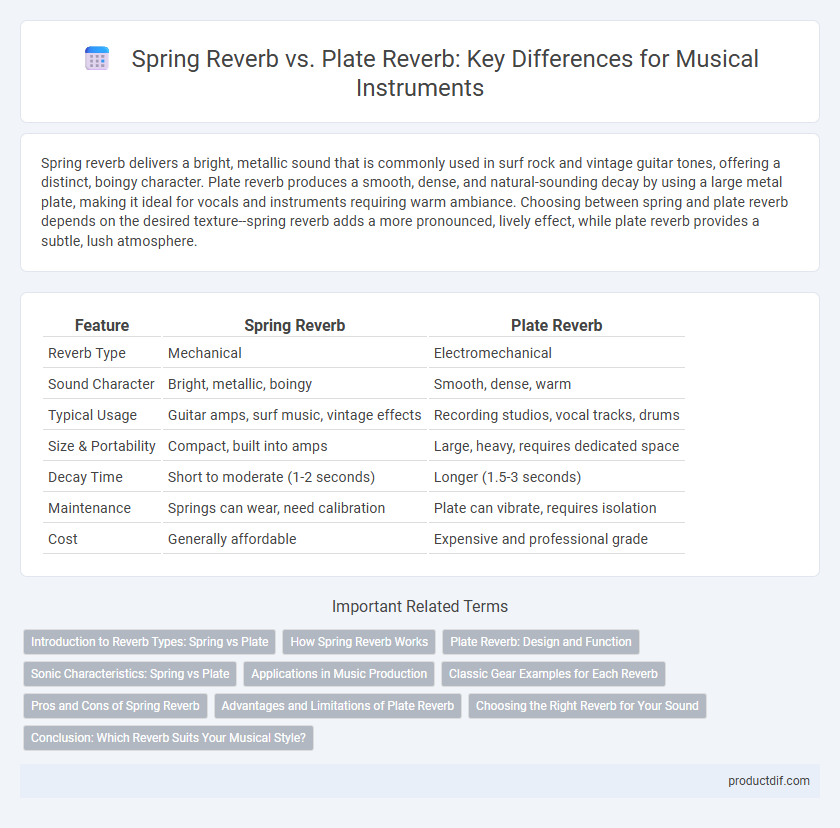Spring reverb delivers a bright, metallic sound that is commonly used in surf rock and vintage guitar tones, offering a distinct, boingy character. Plate reverb produces a smooth, dense, and natural-sounding decay by using a large metal plate, making it ideal for vocals and instruments requiring warm ambiance. Choosing between spring and plate reverb depends on the desired texture--spring reverb adds a more pronounced, lively effect, while plate reverb provides a subtle, lush atmosphere.
Table of Comparison
| Feature | Spring Reverb | Plate Reverb |
|---|---|---|
| Reverb Type | Mechanical | Electromechanical |
| Sound Character | Bright, metallic, boingy | Smooth, dense, warm |
| Typical Usage | Guitar amps, surf music, vintage effects | Recording studios, vocal tracks, drums |
| Size & Portability | Compact, built into amps | Large, heavy, requires dedicated space |
| Decay Time | Short to moderate (1-2 seconds) | Longer (1.5-3 seconds) |
| Maintenance | Springs can wear, need calibration | Plate can vibrate, requires isolation |
| Cost | Generally affordable | Expensive and professional grade |
Introduction to Reverb Types: Spring vs Plate
Spring reverb uses coiled metal springs to create a distinctive, boingy echo favored in surf rock and vintage guitar amps, delivering a tactile, metallic sound. Plate reverb employs a large, thin metal plate suspended in a frame, producing smooth, lush reflections that are highly controllable and popular in studio mixing for vocals and drums. Both types shape spatial perception differently, with spring reverb offering a pronounced mechanical vibe and plate reverb providing a dense, natural decay.
How Spring Reverb Works
Spring reverb operates by sending an audio signal through a set of metal springs, which vibrate to create reflections that simulate natural reverberation. The unique character of spring reverb produces a distinctive, metallic, and slightly pingy tone commonly found in vintage guitar amplifiers and surf music. This physical vibration method contrasts with plate reverb's use of a large metal plate to generate a smoother, more uniform reverb sound.
Plate Reverb: Design and Function
Plate reverb utilizes a large, thin metal sheet suspended within a frame to create rich, dense reverberation by converting audio signals into mechanical vibrations. The design allows sound waves to travel through the metal plate, producing a smooth, warm reverb characterized by longer decay times and a distinctive tonal coloration. This mechanical approach contrasts with spring reverb's use of coiled springs, resulting in plate reverb's superior clarity and a more natural-sounding ambiance favored in studio recordings and mixing.
Sonic Characteristics: Spring vs Plate
Spring reverb produces a distinctive metallic and boingy sound characterized by pronounced resonant overtones, often favored in surf rock and vintage guitar tones. Plate reverb offers a smoother, denser decay with a natural, lush ambiance that enhances vocals and drums without introducing tonal coloration. The tactile vibration of springs creates a gritty texture, while the large metal plate delivers a more transparent and evenly distributed reverberation.
Applications in Music Production
Spring Reverb creates a distinctive, metallic echo commonly used in surf rock and vintage guitar tones, providing a warm, resonant texture that enhances lo-fi and retro music production. Plate Reverb delivers a smoother, more diffuse sound favored in vocal tracks, drums, and orchestral recordings, offering a lush ambiance without overwhelming the original signal. Producers select Spring Reverb for character-driven effects and Plate Reverb for polished, natural-sounding spatial depth across diverse musical genres.
Classic Gear Examples for Each Reverb
Classic spring reverb units like the Fender Amp Reverb and the Vox AC30 are iconic for their metallic, resonant sound often used in surf and vintage rock music. Plate reverb classics such as the EMT 140 and the AMS RMX16 offer a smoother, more dense reverb texture favored in studio vocal and orchestral recordings. These legendary pieces of gear define the tonal characteristics that distinguish spring reverb's gritty vibe versus plate reverb's lush ambience.
Pros and Cons of Spring Reverb
Spring reverb delivers a distinctive, vintage sound characterized by metallic and boingy tones, ideal for surf rock and classic guitar effects. It is compact and inexpensive, making it a popular choice for guitar amplifiers, but it can introduce noise and lacks the smoothness of digital or plate reverbs. The physical springs can also produce mechanical artifacts, limiting their use in high-fidelity recording environments.
Advantages and Limitations of Plate Reverb
Plate reverb offers a smooth, dense, and natural-sounding decay that is ideal for vocals and acoustic instruments, providing a rich ambiance without the mechanical noise often found in spring reverbs. Its limitations include a fixed decay time and size, which restricts flexibility compared to digital or algorithmic reverbs, and the physical size and weight of the plate unit can pose practical challenges in studio environments. Despite these drawbacks, plate reverb remains favored for its warm, lush sound and consistent performance in professional audio production.
Choosing the Right Reverb for Your Sound
Spring reverb delivers a warm, vintage tone characterized by metallic vibrations ideal for surf rock and classic blues, while plate reverb offers a smooth, dense echo preferred in studio recordings for vocals and drums. Selecting the right reverb depends on your instrument's sonic palette and the desired ambiance; spring reverb enhances gritty, raw textures whereas plate reverb thickens and sustains sound with clarity. Experimenting with reverb decay time and pre-delay settings can further tailor the effect to fit genres ranging from psychedelic to pop.
Conclusion: Which Reverb Suits Your Musical Style?
Spring reverb delivers a warm, vintage sound ideal for surf, rockabilly, and blues, adding character with its distinctive metallic resonance. Plate reverb offers a smooth, lush decay favored in studio recordings for pop, jazz, and vocal tracks, providing clarity and depth without overpowering the mix. Choosing the right reverb depends on whether your music benefits from the textured, gritty ambiance of spring or the clean, enveloping sound of plate, aligning with the emotional tone and genre-specific production needs.
Spring Reverb vs Plate Reverb Infographic

 productdif.com
productdif.com